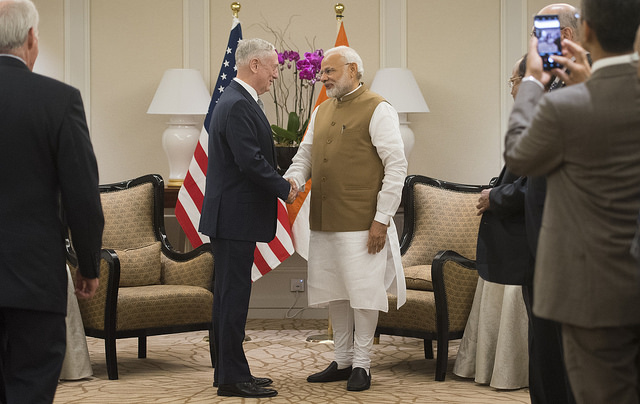
The revival of the so-called Quad or, more formally, the Quadrilateral Security Dialogue, has hogged regional newspaper headlines in the past year—at a time when China’s rise and concurrent assertiveness have sparked much concern across the region.
One would have thought that the concept,
as originally agreed upon by Australia, India, Japan and the United States, would have been brought up by Quad ministers during the
Shangri-La Dialogue last month.
Sometimes, however, the salience of regional security issues lies not in what’s said, but in what isn’t said.
Delivering the keynote at the dialogue, Indian Prime Minister Narendra Modi talked about evolving a ‘common rules-based order’ based on sovereignty, territorial integrity and dialogue. He didn’t mention the Quad specifically.
Similarly, US Secretary of Defense James Mattis spoke about a ‘common rules-based order’ that would apply to all states and the global commons. He didn’t mention the Quad either.
The same applied to the defence ministers from Japan and Australia. Itsunori Onodera spoke about a ‘free and open Indo-Pacific’ that can bring wealth and prosperity to all regional countries. Marise Payne talked about a ‘rules-based global order’ centred on a shared consensus about the rules. But neither mentioned the Quad.
When asked what he thought about the Indo-Pacific strategy, Mattis stressed that the four democracies had a ‘common character’ that led to serious discussions about stability, open navigation and peaceful resolution of disputes. As for the Quad, Mattis said that he had left the term on the cutting-room floor to reduce the length of his speech.
The principles that underpin the Quad are straightforward, and pretty palatable to most countries in the Indo-Pacific: a rules-based order, freedom of navigation and overflight, and respect for international law and maritime security.
But it’s understandable why no ministers hoisted the flag of the Quad during the dialogue. For the Quad to be viable, it needs ASEAN’s support; and for such support to be forthcoming, the grouping mustn’t be seen as a form of soft containment of China.
But ASEAN harbours concerns that any new multilateral grouping such as the Quad could undermine the organisation’s centrality and unity, and could be used to contain China. Tacit coordination among the four Quad ministers at the dialogue could have been possible; if such coordination didn’t actually occur, it’s still a significant coincidence that there was no specific mention of the Quad.
The Quad has several things going for it. It was left for dead in 2008, after the government of Kevin Rudd withdrew Australia’s support in the face of Chinese opposition. In November 2017, senior officials from the Quad countries met on the sidelines of the East Asia Summit to discuss common Quad goals. In May, US Pacific Command was re-named Indo-Pacific Command to reflect its broader remit.
In the medium term, the Quad needs to focus on two major challenges—offering a credible alternative to countries burdened with debt resulting from their participation in China’s Belt and Road Initiative, and deterring further Chinese militarisation of the South China Sea.
The most daunting challenge, however, is securing buy-in from ASEAN. The fact is that ASEAN, whether it formally signs up to the Quad or not, is central to the Indo-Pacific strategies of the US and its key allies.
In his keynote, Modi underscored ASEAN’s leading role in regional integration. Australia’s 2017 foreign policy white paper
stressed that ASEAN, straddling Australia’s northern approaches, is of ‘profound significance’ and the nexus of the Indo-Pacific architecture. Likewise, Japan
deems ASEAN, which sits at the confluence of the Indian and Pacific oceans, as central to its Indo-Pacific strategy.
Writing in
The Strategist, Evan Laksmana
observed that Indonesia’s conception of the Indo-Pacific doesn’t challenge the ‘free and open Indo-Pacific’ concept preferred by Japan and the US; Jakarta also does not oppose ‘minilateral’ arrangements such as the Quad. In addition, Jakarta doesn’t want any Indo-Pacific arrangement to undermine ASEAN’s centrality or exclude certain countries, such as China.
These tenets can be accommodated by the Quad. Modi, Mattis, Onodera and Payne have all stressed that ASEAN’s centrality is vital. As for the inclusionary principle, Quad members could well say that nothing bars a new entrant from joining a Quad-plus arrangement—provided the entrant adheres to shared rules and principles.
This was the case with the ill-fated Trans-Pacific Partnership. Before Trump torpedoed the TPP in January 2017, the deal was seen by the Obama administration as a
platform for the US and its partners to accelerate protection of labour and environmental standards, intellectual property protection, and a free and open internet (rules that China would have had difficulty adhering to). The door wasn’t shut to China explicitly; rather, China would have had to commit to such principles and reform its economy if it had wanted to join the TPP.
In short, ASEAN could still be convinced to sign up to the Quad, if Quad members explicitly state that the grouping isn’t exclusive and wouldn’t undermine ASEAN.
In May, Singapore’s foreign minister, Vivian Balakrishnan,
said that Singapore wouldn’t sign up to the free and open Indo-Pacific strategy or the Quad—at least for the time being. He added that the Quad concept did not adequately address the question of ASEAN centrality. In June, Balakrishnan
said that he was encouraged that both Modi and Mattis had affirmed ASEAN centrality and unity at the Shangri-La Dialogue, and that both India and the US had reaffirmed inclusiveness.
While it might be early days, Balakrishnan acknowledged that such concepts were ideas that Singapore could subscribe to. The details, he added, would need to be worked out and negotiated in the future. ‘Watch this space’, he concluded.
The Quad could well have some legs left. Quad-plus or Qua-sean, anyone?
 Print This Post
Print This Post